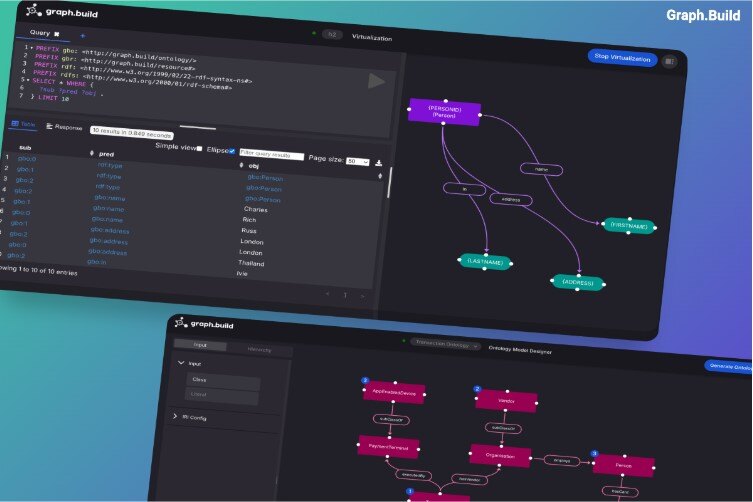Graph Virtualization, Visualizing Imported Ontologies, and Enhanced Neo4j Integration
We are thrilled to announce the latest updates to Graph.Build! This release brings powerful new features to enhance your graph-building experience: Graph Virtualization, visualizing imported ontologies, improved Neo4j integration, and a host of additional enhancements. These updates are designed to further make graph data integration and modelling faster, more intuitive, and accessible.

Graph Virtualization
Graph Virtualization allows you to interact with graph data without the need to replicate it physically. With seamless integration into the Graph.Build Studio, this feature enables users to query and analyse data from any SQL data source as if it were a single, unified graph.
- Efficiency: Eliminate the need to copy large datasets, saving time and resources.
- Real-Time Access: Work directly with the latest data from the source.
- Flexibility: Integrate diverse data sources to uncover new connections and generate deeper insights.
Using Graph.Build Virtualization enables yet another way of interacting with your data as a graph, whether in a test environment or production. By streamlining workflows and reducing storage overhead, Graph Virtualization ensures your data remains consistent, up-to-date, and easily accessible.
Visualizing Imported Ontologies
Understanding data relationships is key to effective graph modelling. With this new feature, users can import an ontology into Graph.Build Studio and it will create a visualization to represent it, automatically visualizing Classes and Properties. Import external ontologies, whether custom-built or widely used standards like FIBO, Schema.org, or FOAF, to simplify exploration and refinement of ontological models. This feature empowers users to leverage existing ontologies while retaining the flexibility to adapt them to specific use cases.
Neo4j Integration Improvements
Neo4j is one of the most popular Labelled Property Graph databases, and we are dedicated to supporting its community and users with seamless integration. In this release, we’ve made significant enhancements, including:
- Support for Neo4j Aura and v5: Easily publish data to the latest Neo4j environments.
- Enhanced Data Types: Support for Neo4j-specific data types in the Studio, Transformers, and Graph Writer, throughout the entire ETL process, ensuring compatibility and ease of use.
These updates solidify Graph.Build’s position as the go-to tool for Neo4j users, enabling streamlined ETL workflows, efficient schema management, and enhanced graph capabilities.
Additional Features
This release also includes a suite of new features and improvements:
- Read-Only Sharing of Visualizations: Share graph visualizations with stakeholders in a read-only mode to enhance collaboration.
- Inheritance Support in Ontologies: Define and visualize inheritance relationships between Classes for intuitive data modelling.
- Preloaded RDFS Vocabulary: Access commonly used constructs such as rdfs:subClassOf and rdfs:label with ease.
- ETL Performance Improvements: Experience faster ETL pipelines for both Semantic and LPG workflows, ensuring scalability for larger and more complex datasets.
What’s Next?
These updates demonstrate our commitment to empowering users with the best tools for graph data integration and modelling. Whether you’re importing, visualizing, and altering ontologies, leveraging the power of Neo4j, or exploring innovative ways to work with graph data, Graph.Build has the solutions you need.
To try out the latest features, download the newest version from AWS Marketplace or Docker Hub. If you’d like a deeper dive into how Graph.Build can transform your workflow, contact us for a demo today.
Follow us on LinkedIn for the latest news, updates, and insights from the world of Graph.Build!
About the Author
Russell Waterson is a Lead Software Engineer at graph.build, specialising in full-stack development with a focus on Knowledge Graphs, Linked Data, and the Semantic Web. With extensive experience in frontend, backend, and cloud technologies, Russell plays a key role in designing and implementing graph-based solutions that help organisations manage and transform their data more effectively.